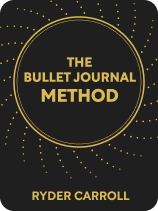

This article is an excerpt from the Shortform book guide to "The Bullet Journal Method" by Ryder Carroll. Shortform has the world's best summaries and analyses of books you should be reading.
Like this article? Sign up for a free trial here .
What is a bullet journal collection? What collections does Ryder Carroll suggest in his book The Bullet Journal Method?
A bullet journal collection can be thought of as a customized section of the journal that’s used to focus on specific topics. Some bullet journal collection ideas would be brainstorming areas, lists, tracking progress, and more.
Here are Ryder Carroll’s collection suggestions.
BuJo Collections
In addition to the four core components—the index, future planner, monthly overview, and daily record—Carroll explains that you’re free to create other collections for your journal.
According to Carroll, bullet journal “collections” are optional journal components focusing on specific topics that either fall outside of—or dig deeper into—the information you record within the four core components. While you can create whatever suits your needs, he mentions that some common collections include plans for projects (personal, like renovating a bathroom, or professional, like a new ad campaign), habit trackers, budgets, and class notes.
(Shortform note: Notably, Carroll doesn’t provide many explicit examples of how to design bullet journal collections. This is likely because he wants readers to embrace the flexibility and creativity of the Bullet Journal and feels that those who are interested in customization can find plenty of inspiration online. However, in reviews of Carroll’s book, some readers expressed that they would’ve liked to see more tips and thought that the book’s practical advice was weak. In other words, they were disappointed that the most knowledgeable Bullet Journal expert—the author himself—didn’t share more of his personal recommendations with his audience.)
Bullet journal collections, Carroll argues, are an integral part of the Bullet Journal Method’s flexibility. There are no limits to what you can create as long as it serves a purpose. For example, don’t track all the movies you’ve watched just to track them. Only record information that adds context and value to your life (like tracking what you watch to increase the amount of female-directed movies you stream).
| What’s Valuable and What’s Not? Carroll argues that you should only track things that serve a purpose or add value to your life. However, for many of us, something’s purpose or value isn’t always clear. What’s more, we can measure value in different ways. In The Life-Changing Magic of Tidying Up, Marie Kondo suggests that you determine the value of a possession primarily by functionality and emotional attachment. In other words, it’s worth keeping if it’s useful or brings you joy in some way. However, she also acknowledges that it’s easy to get caught up in prioritizing function over all else, which results in keeping things that are useful, but that you don’t actually like—and when you don’t like something, you’re less likely to use it. So how can this information help you with Bullet Journaling? When deciding whether the content you’ve created is valuable, consider both its functionality and its capacity to bring you joy. Even if you’re tracking information that could theoretically be useful—such as the amount of water you drink—if you aren’t excited or curious about it, it’s probably not worth keeping in your journal. |
1. Brainstorming
Carroll says that brainstorming is a customization tool that’s particularly useful in the planning stage of projects because it encourages you to jot down ideas, identify variables, and get organized before diving into committed action. For example, in planning a bathroom renovation, you could brainstorm ideas for designs, materials, tools, and more.
As part of your brainstorming process, Carroll recommends organizing your ideas into categories. In the case of the above example, designs, materials, and tools could be potential groupings. Next, he advises that you conduct research within the categories you’ve created, like checking the availability and price points of materials available in your area. In doing so, you not only ease into the project at your own pace but also become more knowledgeable about the subject matter, which prevents you from becoming overwhelmed.
| Additional Brainstorming Tips Carroll’s suggestions for how to organize your ideas while brainstorming are useful, but how do you generate ideas in the first place? There are several potential strategies you could try, including finding associations between words, using prompts like pictures and abstract phrases, and creating hypothetical boundaries—such as time and budget restrictions—to spur creative solutions. To demonstrate, you could use the word-association strategy to brainstorm materials needed for your bathroom renovation. (For example, words that come to mind when you think of the word “material” might be “tile,” “wood,” and “glass.”) Alternatively, if you want to try something other than the traditional notebook-and-pen brainstorming strategy, there are numerous software-based tools that can enhance your brainstorming sessions. These digital tools can make you think more creatively by helping you organize your ideas, providing visual stimulation using colorful charts and images, and enabling real-time collaboration. |
2. Making Lists
As discussed in Part 2, Carroll argues that bulleted lists are a fundamental part of the Bullet Journal Method’s journaling system. Not only should you use them in your daily records, monthly overviews, and future planner, but you can also take advantage of them in different collections by tailoring them to your needs.
Just as with your daily record, Carroll says you can use signifiers to prioritize certain list items. In addition, you can add context to your lists by drawing columns on the right that include information about variables like location, time, and cost. For example, if you’re creating a list of materials you’ll need for your bathroom renovation, you could add a column that indicates the price of each material.
(Shortform note: Carroll offers advice for how to further customize lists, but he doesn’t speak to the specific benefits of list-making and why it’s such a helpful tool. First, lists help you prioritize—by seeing what needs to get done, you can better isolate the most urgent tasks. Similarly, by writing out a list, you can easily group related tasks, which can save you time and energy. Additionally, making lists can help you declutter your mind and clear more mental space for focusing on the present. Finally, crossing off completed items from your list can be motivating, as you feel a sense of accomplishment with each task you finish.)
3. Designing Schedules
Carroll says that regardless of the project you’re working on, time is an important factor to consider, so creating a schedule is a good idea. Although the design of your schedule will vary depending on the project, Carroll recommends that you base it on the most relevant variables impacting your project.
For example, if you’re creating a timeline for your renovation, you might consider the specific tasks involved, the order in which you need to complete them, and their deadlines. You may even need to consider the availability of any contractors you’re working with so that you can plan your schedule accordingly.
(Shortform note: In addition to Carroll’s recommendations for which variables to consider when designing your schedule, the project management field offers plenty of scheduling inspiration. When creating a project schedule, project managers include a variety of details that are essential to guiding their team through a project. They consider variables such as the project budget, expected task durations, potential risks that could derail the project timeline, labor and material resource availability, and task “dependencies”—which define the order in which workers must complete the project’s tasks.)
4. Tracking Progress
When using your journal to monitor progress toward your goals, Carroll argues that there are endless opportunities for creativity in both the design itself and in what you choose to track. As long as what you’re tracking gives you valuable insight, you can track anything from your savings goals, to the books you read, to how often you exercise each month.
Depending on what you track, Carroll recommends either creating an individual bullet journal collection or adding a tracker to your monthly overview. He says that tracking your progress through your monthly overview is especially useful for tracking your habits. To do this, first add a key for whatever habits you want to track (for example, R = Read). Then, create columns to the right of your monthly overview calendar for each habit. Finally, add a task bullet for each date of the month that you can X off on the days you complete the task.
Monitoring your progress yields valuable insights that can increase your self-awareness. One way in which you can glean these insights is by comparing your tracker to your daily records. (For example, you may realize after looking at your last daily record that you didn’t read yesterday because you were busier than normal.) Additionally, you can observe your habits over time to discover what’s working and what isn’t. (For instance, you may come to realize after tracking your reading habits that a goal of 30 minutes of reading per day is too unrealistic for your hectic schedule.)
(Shortform note: Although Carroll argues that monitoring your progress can increase self-awareness, he doesn’t explain why this is the case. Research shows that despite our best intentions, we’re terrible at self-reporting our behavior because we tend to recall things not as they really were, but as we expected or wanted them to be. This means that we can’t rely on our perception when reflecting on our behavior. Monitoring progress can help us build better self-awareness by providing objective behavioral data that aren’t tainted by our skewed recollections.)
5. Long-Form Journaling
Although the Bullet Journal Method is based on efficiency, Carroll explains that there are some cases in which you may want to utilize long-form journaling. As you fill in your daily record, you may feel that certain entries require more time and thought than a simple bullet. In this case, Carroll advises that you turn the entry’s “-” note symbol into a “+” so that you remember to expand on it during your daily review. By using long-form journaling, not only can you better articulate your thoughts, but you can also reduce stress and anxiety.
(Shortform note: In addition to reducing stress and anxiety, research shows that traditional journaling has other overall health benefits. In terms of mental wellness, journaling can increase your working memory capacity, give you a greater sense of happiness, and improve various psychological functions like emotional regulation, creativity, and sense of self. As for physical wellness, writing expressively can strengthen your immune system, lessen the symptoms of ailments like asthma and arthritis, and even help wounds heal quicker.)

———End of Preview———
Like what you just read? Read the rest of the world's best book summary and analysis of Ryder Carroll's "The Bullet Journal Method" at Shortform .
Here's what you'll find in our full The Bullet Journal Method summary :
- A comprehensive guide to using the Bullet Journal Method
- How to maintain a journaling practice that can improve your overall quality of life
- How to extend the method beyond productivity to a practice in mindfulness






